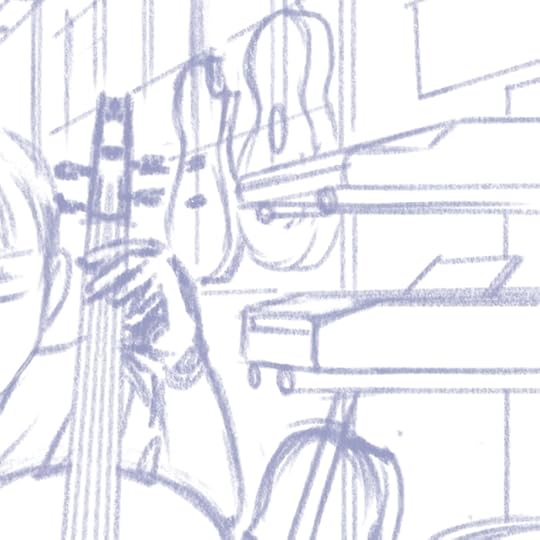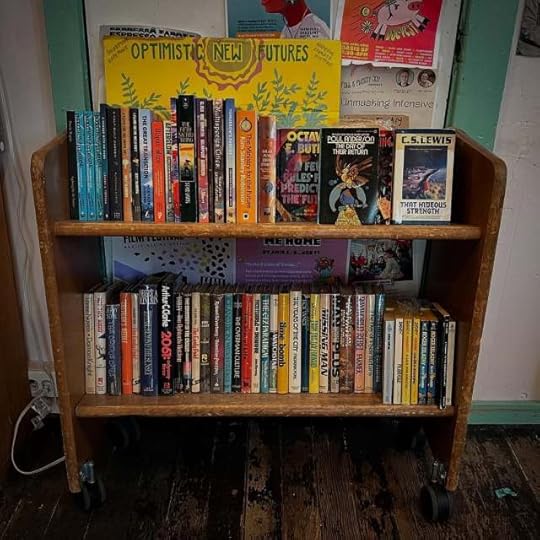Marc Weidenbaum's Blog, page 23
April 19, 2025
Scratch Pad: Earth, Earbuds, Reading
At the end of each week, I usually collate a lightly edited collection of recent comments I’ve made on social media, which I think of as my public scratch pad. I find knowing I’ll revisit my posts to be a positive and mellowing influence on my social media activity. I mostly hang out on Mastodon (at post.lurk.org/@disquiet), and I’m also trying out a few others. And I generally take weekends off social media.
▰ Picked up my Earth ticket on Sunday evening when I happened to walk by the Chapel on Mission. Can’t remember the last time I bought a physical ticket at a venue days in advance of a show.
▰ Changing from one brand of earbuds to another means learning a whole new range of controls and context-specific sounds, and getting used to a different set of options, and to the unique tonality of the sonic artifacts resulting from digital processing.
▰ I probably should have turned on the lights in the kitchen before preparing granola this morning. If it’s possible to overdose on nutmeg, I’ll know shortly.
▰ Afternoon trio for dryer, bathroom fan, and passing bus.
▰ Read a lot this week (Adrian Tchaikovsky’s Children of Time, Michael Connelly’s The Black Echo), but only finished reading one book, a graphic novel titled The Phantom Scientist by Robin Cousin, who tells a story at once scientific and elliptical, with strong echoes of Chris Reynolds and Jason Shiga, not to mention Don DeLillo. I really dug it, but if someone can explain its ending to me as being anything more than artfully oblique, I’d be thankful.
April 18, 2025
From Little Things
The installation artist Zimoun specialized in large-scale exhibits where substantial batteries of physical objects combine to make a lot out of a little, whether it’s ping pong balls, or springs, or cardboard boxes, or piano strings, or polyethylene tanks, or DC motors, or cotton balls — or, generally, two or more of those in combination. Experienced in person, the works take on a semi-lifelike, if not necessarily sentient, quality — that is, they are “generative” (in the sense that predates the near wholesale accession of that term by commercialized artificial intelligence). By contrast, Zimoun documents these with short videos that are, if you’ve seen the work close up, akin to a postcard representing a cross-country trip, not so much shorthand or short shrift as a considered encapsulation. Among his latest, from this still fairly new year, is “24 prepared dc-motors, 24 metal barrels, 265m piano strings” (the pieces usually have titles determined by their constituent parts), which summons up an orchestral drone, as the vibrating strings cause deep emanations from the metal drums.
April 17, 2025
Disquiet Junto Project 0694: 5/4ify

Each Thursday in the Disquiet Junto music community, a new compositional challenge is set before the group’s members, who then have five days to record and upload a track in response to the project instructions.
Membership in the Junto is open: just join and participate. (A SoundCloud account is helpful but not required.) There’s no pressure to do every project. The Junto is weekly so that you know it’s there, every Thursday through Monday, when your time and interest align.
Tracks are added to the SoundCloud playlist for the duration of the project. Additional (non-SoundCloud) tracks also generally appear in the lllllll.co discussion thread.
Disquiet Junto Project 0694: 5/4ify
The Assignment: Add a beat to a pre-existing piece of music.
There is just one step to this project: Take a pre-existing piece of music that is in 4/4 — either your own or something in the public domain — and add a beat to each measure, transforming it into 5/4.
Tasks Upon Completion:
Label: Include “disquiet0694” (no spaces/quotes) in the name of your track.
Upload: Post your track to a public account (SoundCloud preferred but by no means required). It’s best to focus on one track, but if you post more than one, clarify which is the “main” rendition.
Share: Post your track and a description/explanation at https://llllllll.co/t/disquiet-junto-0694-5-4ify/
Discuss: Listen to and comment on the other tracks.
Additional Details:
Length: The length is up to you. Maybe 25% longer than usual?
Deadline: Monday, April 21, 2024, 11:59pm (that is: just before midnight) wherever you are.
About: https://disquiet.com/junto/
Newsletter: https://juntoletter.disquiet.com/
License: It’s preferred (but not required) to set your track as downloadable and allowing for attributed remixing (i.e., an attribution Creative Commons license).
Please Include When Posting Your Track:
More on the 694th weekly Disquiet Junto project, 5/4ify — The Assignment: Add a beat to a pre-existing piece of music — at https://disquiet.com/0694/
April 16, 2025
Detail of a Draft of an Installment

Yeah, there’s a new installment coming soon in the Frame by Frame comics series I’m collaborating on with Hannes Pasqualini. Here’s a detail of a rough draft of one of the panels. Full archive at disquiet.com/fxf.
Zen Metal

This is the band Earth performing at the Chapel in San Francisco on the evening of April 15, 2025, on a tour that marks the 20th anniversary of the album Hex: Or Printing in the Infernal Method. They were pretty darn good in this expanded, quartet formation, with Steve Moore (aka Stebmo) on trombone and keyboards, and Bill Herzog on bass. Adrienne Davies was, as always, transfixing, as she played at what for most drummers would be a quarter of regular speed. Dylan Carlson, Earth’s founder, has said he aimed for “ambient metal” with the band, and this evening was like “zen metal,” just grounded, singular riffs played on repeat with a compelling attention to tone and pace. The light show — note: all those splendid, gooey images moved — was by Mad Alchemy.
April 15, 2025
Frame by Frame Coverage
Two wonderful mentions of the Frame by Frame comics that Hannes Pasqualini and I have been up to:
1. It was rewarding to see, quite unexpected, this shout-out from novelist Robin Sloan (Mr. Penumbra’s 24-Hour Bookstore, Moonbound) in the latest issue (April 2025) of his main newsletter. Our mention was slotted in between recommendations by Sloan of a book on typography in film and an essay on synthesizer presets — in other words, fine company.

2. The wavelight blog of ioflow, a talented musician whom I know through the world of Monome instruments and the llllllll.co BBS, includes a detailed close read of many of the Frame by Frame comics to date. Here is one section of his essay, in which he lists some connections he identified between our installments:

April 14, 2025
“Avril 14th” 2025
There are many great electronic holidays, like those associated with various Roland instruments: 808 Day (for the TR-808 Rhythm Composer, August 8), 404 Day (for the SP-404, April 4), 303 Day (for the TB-303, March 3). My favorite is April 14, for Aphex Twin’s “Avril 14th,” off the 2001 album Drukqs. Many cover versions appear each year, and I’ll share some of my new favorites as the today proceeds.
Here’s flute (Serena Huang) and violin (Michael Shingo):
Here’s a harp (Sáoirse Éirinn) and pedal steel (Joel Harkin) duet rendition:
And it wouldn’t be Avril 14th without a Moog cover, this from a musician who goes by Sequence Mode:
Shane Parish on acoustic guitar, plus birdsong:
An upbeat rendition, entirely on the Elektron Analog Rytm, from my friend RPLKTR (Łukasz Langa)
And on the Sunvox software synth:
April 13, 2025
Celebrating Herbie’s 85th
How did I not know there is a small jazz club in San Francisco, just off Market Street, with a menu consisting of dim sum and a cocktail called the Oxford Comma?

It’s called Mr. Tipple’s. I caught a set there Saturday evening: bassist Kevin Goldberg’s quintet doing the music of Herbie Hancock on the great one’s 85th birthday, closing with a fantastic “Watermelon Man,” off Hancock’s 1962 album Takin’ Off, his solo debut. Goldberg’s band included Will Comer, piano; Ashley Jemison, alto saxophone; Mario Silva, trumpet; and Miles Turk, drums.





